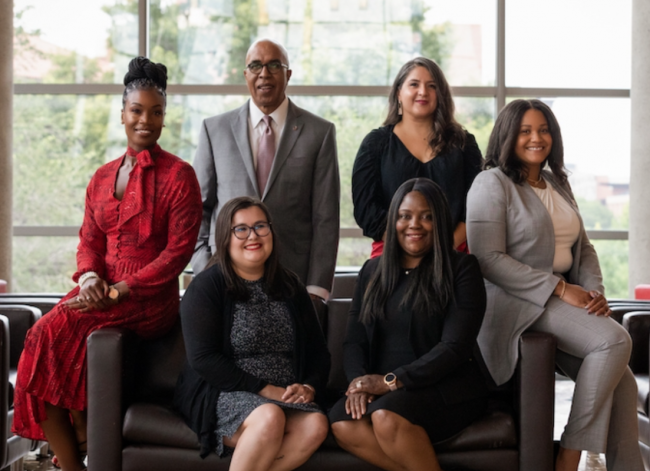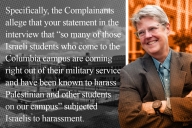You have /5 articles left.
Sign up for a free account or log in.

Some of the first Dean’s Diversity postdoctoral fellows, with Don Pope-Davis, standing, second from left, and Noelle Arnold, seated, right.
Ohio State University
There are several extraordinary things about the Dean’s Diversity Postdoctoral Fellows Program at Ohio State University’s College of Education and Human Ecology. Unlike many postdocs, fellows are treated like the actual advanced trainees they are, not just extra instructors or researchers. Fellows are encouraged to pursue their own research agendas during the college’s two-year program, not work on some other professor’s grant. And the college accepts fellows as cohorts, ensuring that these underrepresented scholars have a sense of community and peer support.
Ohio State pays accepted fellows to relocate there, along with a $55,000 salary and full employee benefits. Different from other well-intentioned but oft-unfunded diversity initiatives, this one pays fellows’ faculty mentors, too -- signaling that this work with junior scholars of color is truly valued.
Most exceptionally, postdocs are hired with the expectation that they will be eligible for tenure-track faculty appointments at the end of their terms. And Ohio State made good on that commitment to its inaugural class of nine fellows -- it hired five of them into tenure-track professorships, via targeted searches.
Those former fellows -- now professors -- start teaching this week.
“This program was purposefully crafted and very intentional,” said Kristen Mills, an inaugural class fellow and new assistant professor of education at Ohio State. “It eliminated so many barriers and made so many things plain.”
How well crafted is the program? Mills, whose background is in community psychology, said she wasn’t even sure she wanted a faculty job when she applied to the postdoc program, among other fellowships. But Ohio State was so welcoming, starting with a multiday interview process, and the program itself provided such a grounding in faculty work that Mills ultimately decided to stay in academe.
“Faculty life is not singular. There’s no one job you’re doing,” said Mills, who studies academic resilience and racism. “And we were able to experience all parts of faculty life, with the exception of advising students. Every other responsibility we were able to live and test and figure out, ‘Yes I do want to do faculty life.’ You can strive for work-life balance. Despite all those scary things we hear, it can be good. It can be exactly what you want.”
Designing for a Seamless Transition
Don Pope-Davis, dean of the college, said, “We were very intentional in giving postdocs this experience as though they were regular faculty members, doing teaching, research and so forth. That was important, so that there would be no or very little disconnect between the experiences of being a postdoc and being a regular faculty member.”
Pope-Davis continued, “We [also] said to the postdocs, ‘We want you to start developing your own research area, and we will support you in that.’”
All these elements were crucial to the goal of the program, what Pope-Davis called a “grow-your-own” approach to building faculty excellence through diversity. While the college continues to recruit more senior scholars who contribute to faculty diversity, Pope-Davis is investing in training scholars at the postdoc level as well. And he’s hoping to get a return on the investment by targeting those postdocs for tenure-track faculty hires at the end of the fellowship.
In so doing, he’s making a statement and, in his words, “transforming perspectives.”
“We wanted to change the culture and the environment,” Pope-Davis said. “It’s an internal commitment to, to use the expression ‘from cradle to grave,’ where we bring people into our space. We treat them in a particular way, enhance their skills, give them pedagogical training, and say, ‘Our intent is to hire you as a tenured faculty member in our college.’”
Whereas some other institutions’ diversity initiatives involve hiring postdocs for a year or two, Pope-Davis said that is “more of an optic commitment.” Here, he said, “we are establishing a pipeline.”
Postdocs don’t typically get hired directly into faculty roles at that same institution. Often, faculty members insist on national searches for a new colleague, with a bias toward outside candidates. At Ohio State, Pope-Davis said he worked with professors in his college, some of whom served as program “ambassadors” to their departments, to bring the faculty as a whole around to the idea of targeted searches.
“You’re always pushing against a notion of change,” he said. “And people are invested in the status quo. So part of my job as the dean is to disrupt that and lead in a way that allows the unit to be transformative. And quite frankly, we no longer have to beg people to be part of this. People are coming to us and saying, ‘How do we get involved?’”
Great Expectations, More Resources
Scholars enter the Dean’s Diversity postdoc program with a clear set of expectations they must meet if they are to remain eligible for a faculty job. They’re to spend approximately 60 percent of their time on scholarship, pursing an independent line of inquiry. The college encourages collaboration and interdisciplinary work, so it supports collaboration as well. Postdocs spend 10 percent of their time teaching, in the form of one class per year. They create the syllabus, mentors review their teaching and, per university rules, students also evaluate the instruction. Service to the college and university make up 15 percent of the postdocs’ time, as does professional development.
Scholars must enhance the college’s commitment to diversity and inclusive excellence. The program is targeted toward traditionally underrepresented scholars of color.
Fellows check in frequently with their assigned mentors, but they’re formally reviewed annually. Postdocs are ultimately required to submit at least one grant or funding proposal, internal or external, and at least two peer-reviewed journal articles (one of which must be a first-author publication) to a high-quality journal; design and teach one course; participate in a service activity; and attend college programs and department meetings. Scholars complete biweekly professional development activities designed for them, on topics such as time management, teaching excellence, transitioning to the tenure track and grant writing.
The postdocs who meet these benchmarks are targeted for a tenure-track position within the college. Targeted searches are not traditional open searches. Instead, they seek out candidates who provide the academic unit something it’s lacking, in experience or expertise, and who contribute to the unit’s diversity initiatives. While fellows may be the only candidate for the job, they are required to complete the interview process.
That process remains a two-way street: postdocs are in no way required to remain at Ohio State. But five will, so far. At least one other postdoc is taking another year in the program.
Marc Guerrero, an associate professor of education at Ohio State who was matched with Mills as her primary mentor based on their similar research interests, agreed that the fellowship is well designed but said much of its success “was on the postdocs themselves -- their drive and determination to be successful within this program.” Mills, for instance, knew the requirements for the program inside and out and took advantage of the professional development opportunities available to her, whether they were sponsored by the college or not, Guerrero said.
Rhodesia McMillian, another former fellow and incoming assistant professor at Ohio State, was awarded a $72,000 grant from the Spencer Foundation to study educational jurisprudence in the U.S. while she was in the program. That’s certainly a reflection of her work. But McMillian said she wouldn’t have been able to achieve the grant without the program, as it demystified and supported her during the grant-writing process, and so many other parts of faculty life.
“The resources matched the expectations,” McMillian said of the program. Regarding grants, in particular, McMillian said the college arranged bimonthly grant-writing retreats and opportunities for feedback on proposals from more senior scholars. That feedback often centered on budget organization, writing clear abstracts and making sure theory, methods and research questions were salient for the reviewers. All the while, she said, Pope-Davis and others “encouraged us to be innovative and progressive in our proposals.”
Steven Stone-Sabali, an incoming assistant professor who was supported by the program, agreed that the fellowship matched expectations with “outstanding” resources. Like his colleagues, Stone-Sabali is starting his assistant professorship with grants -- two of them.
Beyond the program’s design, Stone-Sabali, who studies how mental health intersects with race and education, said he also appreciated that so many people of color held faculty and administrative roles within the college.
“They had the multicultural competence to understand the unique experiences that faculty of color face in the academy,” he said. “That assured me that I would be working in a more inclusive environment.”
A Model for Diversity?
Faculty members of color already make up 30 percent of the college. Pope-Davis is Black, as is Noelle Arnold, senior associate dean in the college and director of the postdoc program. But Arnold said it was always important that the postdoc program in particular recruit underrepresented scholars as a robust cohort. Some 100 scholars applied and 15 were brought to campus to interview. Again, nine were selected and hired.
“From the beginning, [Pope-Davis] said, ‘Make it happen, and I don’t want one or two,’” Arnold recalled. “That’s another piece of why this has been so successful.”
Arnold and Pope-Davis are currently fundraising and planning to begin recruiting another cohort. They want to publish an academic article about the design of their program, how effective it’s been thus far and why, as well.
Pope-Davis said the postdoc-to-faculty model could be adopted by other institutions to promote their diversity goals, as long as the program is designed intentionally and the culture of the greater department, college or university supports it.
Diversity initiatives don’t have to be sweeping or cost tens of millions to make real change, he added.
“We got a commitment from each of the departments. We partnered with faculty. We partnered with department chairs. And we provided the resources centrally to make it sustainable.”
Already the Dean’s Diversity program has made an impact outside the College of Education and Human Ecology: Ohio State’s College of Engineering has announced a similar program, called Leading Engineering as Agents of Change and Equity, or LEGACY.
Ayanna Howard, dean of engineering, said she knew she wanted to adopt the LEGACY program even before she arrived at Ohio State earlier this year. But seeing the Dean’s Diversity program and talking with people involved helped her envision just how the program might work on that campus, she said.
“I met with them to pick their brains about metrics for success and key elements, which helped us think through the initial pieces of the LEGACY program and figure out how their program elements could be adapted to the engineering culture,” Howard said.
Similar to the education postdoc program, the LEGACY program is based on a cohort model, has multidimensional mentorship, starts with the intent to hire and focuses on postdocs’ training and growth.
Shirley Yu, an associate professor of educational psychology who served on the search committee and as a teaching mentor, said exporting the program would require “faculty members who back you, and have shared values in terms of inclusion and the need to diversify the faculty.” Serving on the search committee was a “huge time commitment” due to the number of applications, she said, “but this is aligned with my own professional values and research, so it works out really well.”
Over all, she said, “it’s very exciting to be part of a diversity initiative that is so innovative and can serve as a model for other departments and colleges and universities.”









